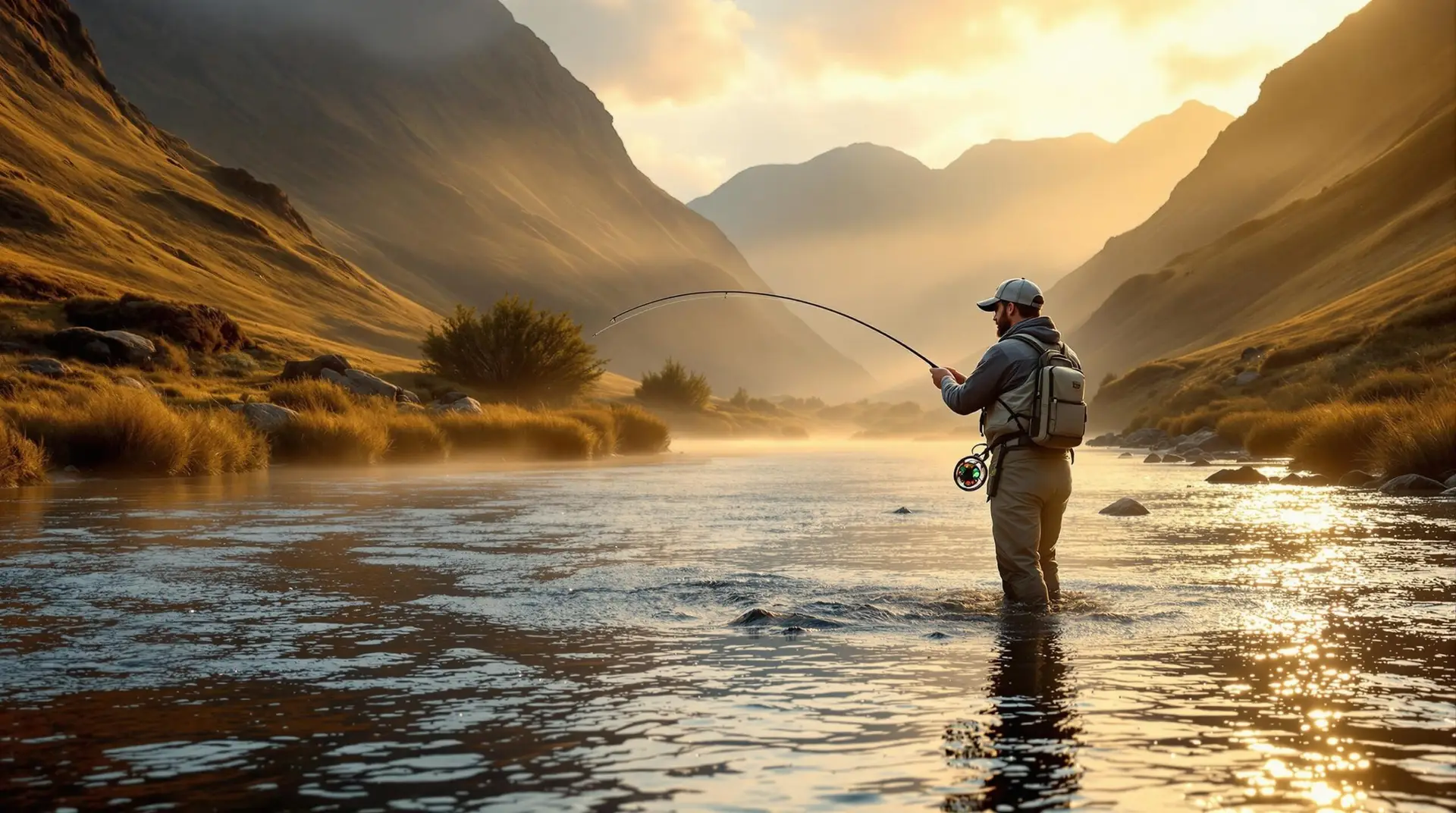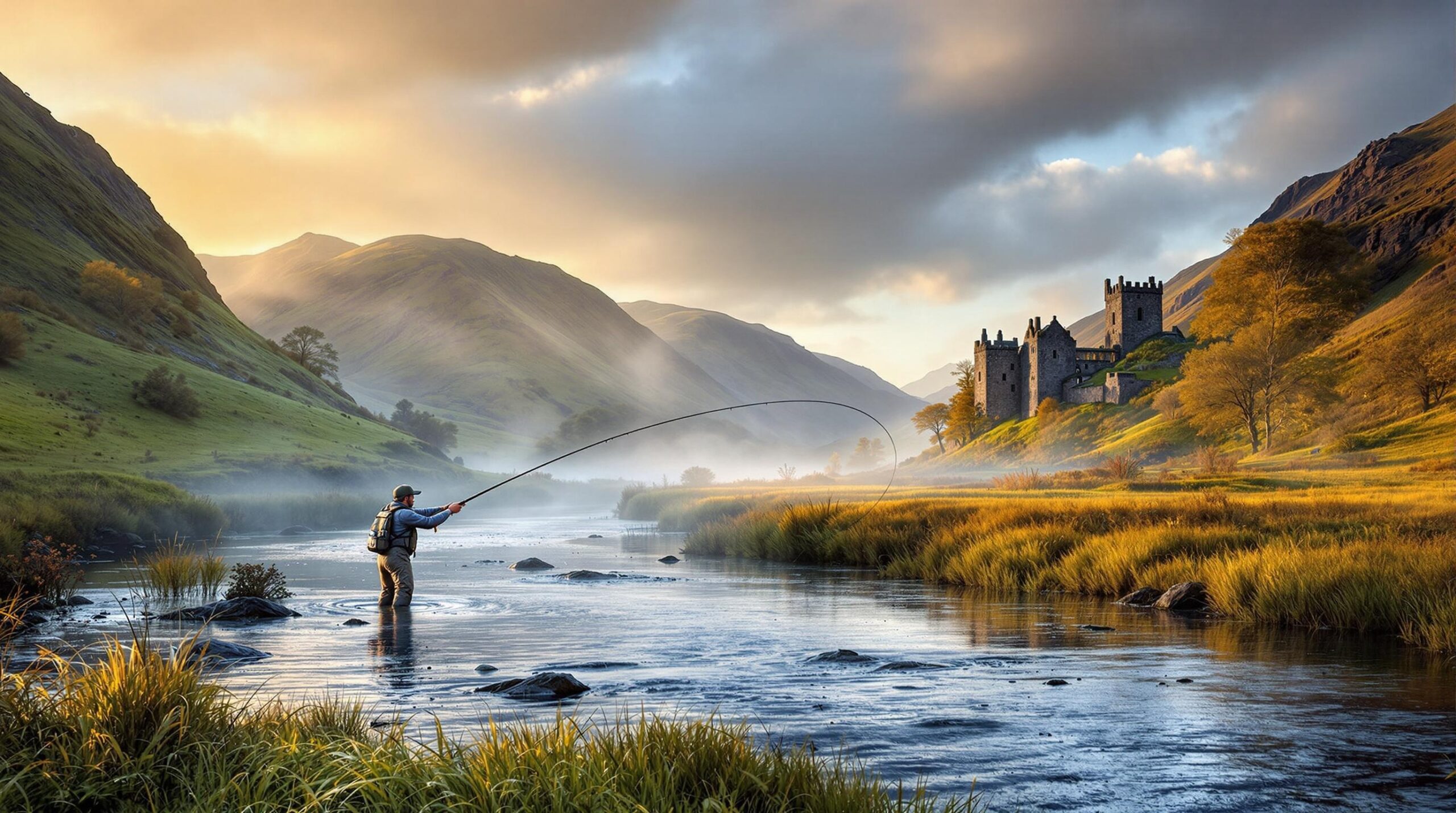According to a recent scientific study on Scottish salmon catch trends, anglers in Scotland record over 6,000 fly-caught sea trout and nearly 3,000 salmon annually across its pristine waterways, making it one of Europe’s premier fly fishing destinations. Fly fishing in Scotland offers an unparalleled experience with diverse landscapes ranging from legendary rivers and spectacular lochs to coastal waters, all teeming with prized species like Atlantic salmon, sea trout, brown trout, grayling, and pike.
Key Takeaways
- Scotland boasts over 6,000 fly-caught sea trout and nearly 3,000 salmon annually across pristine waterways
- The River Tweed contributes substantially to Scotland’s 2,927 fly-caught salmon each year
- Loch Awe offers opportunities to catch trophy pike exceeding 20 lbs
- Shetland Islands provide access to over 300 lochs with a single permit
- Climate change has led to a 45.7% decline in salmon in the NW Highlands (1980-2023)
Legendary Scottish Rivers for Premier Fly Fishing in Scotland
Scotland’s rivers represent the pinnacle of fly fishing opportunities in Europe. With waters that have been carefully managed for generations, these iconic waterways offer both quantity and quality for anglers seeking memorable experiences. According to UK government fisheries statistics, over 56% of salmon catches in Scotland come from fly fishing techniques, underscoring the effectiveness of this method in these waters.
River Deveron: Aberdeenshire’s Fly Fishing Gem
The River Deveron flows through Aberdeenshire, offering exceptional fly fishing in Scotland with convenient access points from Huntly. This remarkable river hosts healthy populations of salmon, sea trout, and brown trout throughout its course. Anglers typically employ swinging flies with double-handed rods in the broader sections, while Euro-nymphing techniques prove effective in the narrower stretches. The river provides excellent opportunities for both beginners and seasoned anglers, with peak fishing typically occurring from late spring through autumn.
River Tweed: Border Waters Teeming with Game Fish
The River Tweed, straddling the border between Scotland and England, has earned its legendary status among fly fishers worldwide. Famous for Atlantic salmon, sea trout, and grayling, this river contributes significantly to Scotland’s annual salmon catch. The lower reaches near Melrose represent hotspots for large sea trout, particularly during dawn and dusk. Seasonal peaks occur during spring and autumn for salmon, while winter offers prime grayling fishing. For those targeting salmon, Ally’s Shrimp patterns have proven consistently effective in these waters.
River Thurso: Highland Solitude and Salmon
Flowing for 26 miles through the Scottish Highlands, the River Thurso provides peaceful fly fishing in Scotland with limited angler numbers. This exclusivity ensures a serene experience while pursuing Atlantic salmon, brown trout, and sea trout. The river reaches its peak fishing condition during spring and early summer when water levels typically remain stable. Traditional wet fly approaches work well here, but don’t overlook the excitement of skating dry flies across likely holding areas, particularly during summer evenings.
Spectacular Lochs for Fly Fishing in Scotland’s Heartland
Scotland’s lochs offer a completely different fly fishing experience compared to its rivers. These vast bodies of water host diverse fish populations and often require different techniques and equipment. Many anglers visiting Scotland combine both river and loch fishing for a comprehensive experience of European fly fishing locations.
Loch Awe: Scotland’s Trophy Fish Destination
As Scotland’s longest loch near the West Coast, Loch Awe lives up to its name with awe-inspiring fly fishing in Scotland. Target species include large trout, salmon, and pike, with some specimens exceeding 20 pounds. Boat fishing proves most effective, utilizing sink-tip lines and substantial streamers to entice the loch’s larger residents. Beyond the fishing, Loch Awe offers stunning views of Kilchurn Castle, making it a destination that combines angling excellence with historical significance. The most productive fishing typically occurs during spring and early autumn.
Loch Leven: Brown Trout Paradise
Located north of Edinburgh, Loch Leven has earned its reputation for distinctive aggressive brown trout that provide exceptional sport on the fly. These trout typically average 1-2 pounds, though specimens up to 5 pounds are caught regularly. Fishing is conducted exclusively from boats, with intermediate lines proving most effective. Large streamer patterns like Bunny Leech variations consistently produce results. For those seeking variety, the loch also hosts a substantial pike population that readily takes appropriately sized flies.
Shetland Isles’ Hidden Treasures
The remote Shetland Islands offer perhaps the most underrated fly fishing in Scotland, with over 300 lochs accessible via a single permit from the Shetland Angling Association. According to the Shetland tourism authority, anglers can expect impressive catch rates of 1-20 wild brown trout per hour in these pristine waters. Notable locations include Lochs Tingwall and Asta, which consistently produce quality fish. While the logistics of reaching the Shetlands require additional planning, the exceptional fishing rewards the effort.
Regional Hotspots for Fly Fishing in Scotland’s Diverse Landscapes
Scotland’s varied geography creates distinct regional fishing characteristics worth exploring. From famous whisky-producing regions to remote highlands, each area offers unique fly fishing opportunities. These regional variations contribute to Scotland’s status as one of the best fly fishing destinations globally.
Speyside: Birthplace of the Famous Casting Technique
The Speyside region, centered around the River Spey and its tributaries like Knockando Burn, represents the spiritual home of fly fishing in Scotland. This area gave birth to double-handed rods and the Spey casting technique that revolutionized fly fishing worldwide. Seasonal highlights include spring for early salmon runs and autumn for larger multi-sea-winter fish. According to Loop Tackle’s fishing guides, Speyside contributes significantly to Scotland’s annual 6,353 fly-caught sea trout. Between fishing sessions, the region’s famous distilleries offer excellent diversions.
Highland Waters: Remote Wilderness Fishing
The Scottish Highlands provide wilderness fly fishing experiences on rivers like the Oykel and Shin, plus lochs like Maree with rare Arctic char populations. Research from Aberdeen University has documented concerning climate change impacts, including declining salmon sizes based on a 60-year Girnock Burn study. The remote nature of Highland fishing requires proper preparation, including appropriate wading gear, rain protection, and sometimes satellite communication devices for safety in these isolated settings.
Lowland Opportunities for Accessible Fly Fishing in Scotland
The Scottish Lowlands offer more accessible fly fishing options on rivers like the Clyde and Earn. These waters host healthy populations of grayling and brown trout, making them ideal for technical fly fishing approaches like Euro-nymphing with Red Tag or Hare’s Ear patterns. Winter fishing for grayling can be particularly productive, with trophy specimens exceeding 40 centimeters not uncommon. The Lowlands also typically offer more day ticket options and better access infrastructure compared to Highland waters.
Saltwater Fly Fishing in Scotland’s Coastal Waters
Scotland’s extensive coastline provides overlooked fly fishing opportunities that more anglers are beginning to discover. These saltwater options extend the fishing season and offer exciting alternatives when river conditions aren’t ideal. For those interested in advanced fly fishing destinations worldwide, Scotland’s coastal waters deserve consideration.
Targeting Pollock and Sea Bass Along Scottish Shores
Prime locations for saltwater fly fishing in Scotland include Dunbar and the Mull of Galloway, with the seasonal window extending from May through October. According to Alba Game Fishing, boat fishing with substantial streamer flies on 8-10 weight rods proves most effective. Pollock typically ambush prey near kelp beds and drop-offs, making these structures prime targets. Trophy potential is significant, with fish exceeding 10 pounds caught regularly by those employing proper techniques and timing their outings with favorable tides.
Coastal Fishing Tactics and Equipment
Successful saltwater fly fishing in Scotland requires specialized gear and approaches. Fast-action 9-foot rods in weights 8-10 paired with saltwater-resistant reels and intermediate or sinking lines form the foundation. Tidal considerations significantly influence success, with moving water typically producing better results than slack tide periods. While shore-based opportunities exist, boat access dramatically increases productive water coverage. Weather conditions affect coastal angling more severely than inland fishing, so flexibility in planning proves essential.
Planning Your Fly Fishing in Scotland Adventure
Creating a successful fly fishing trip to Scotland requires careful preparation and knowledge of regulations, conservation practices, and local customs. This planning ensures both enjoyable fishing and the preservation of Scotland’s aquatic resources for future generations.
Conservation Awareness and Sustainable Practices
Scotland has experienced both conservation successes and challenges in recent decades. The Loch Fleet brown trout restoration represents a positive example, while broader climate impacts on salmon migration patterns raise concerns. According to Galloway Fisheries Trust, regional variations in fish populations are significant, with NW Highlands experiencing a 45.7% decline in salmon but a 19.1% increase in grilse between 1980-2023. Practicing catch and release, particularly for larger breeding fish, contributes to conservation efforts. Supporting local conservation organizations through membership or donations further aids in preserving Scotland’s fishing heritage.
Permits, Seasons, and Practical Information for Fly Fishing in Scotland
Permit requirements for fly fishing in Scotland vary significantly by region and water type. Most productive salmon rivers require advance booking, often a year ahead for prime beats during peak seasons. Lochs typically have more accessible permit systems, with day tickets available from local shops or online. Seasonal restrictions protect spawning fish, with most salmon rivers closed between late September and early February. When planning accommodations, consider locations near your primary fishing destinations to minimize travel time and maximize water time during your Scottish angling adventure.
Frequently Asked Questions
When is the best time of year for fly fishing in Scotland?
The optimal time depends on your target species. For Atlantic salmon, April-June and September-October typically offer the best fishing. Brown trout fishing peaks from May through September, while grayling fishing excels during winter months (November-February). Weather and water conditions can significantly influence success regardless of season.
Do I need a guide for fly fishing in Scotland?
While not mandatory, hiring a guide for at least your first few days proves highly beneficial, especially on salmon rivers. Guides provide valuable local knowledge about productive spots, effective techniques, and proper etiquette. Many Scottish waters have unique characteristics that seasoned local guides understand intimately, potentially saving you days of trial and error.
What permits do I need for fly fishing in Scotland?
Unlike some European countries, Scotland doesn’t require a national fishing license. However, you must obtain permits for specific waters. These range from day tickets for smaller streams and lochs to week-long beats on premium salmon rivers. Prices vary dramatically, from £10 for loch fishing to £500+ daily for prime salmon water during peak season.
What fishing equipment should I bring to Scotland?
For salmon, bring 13-15ft double-handed rods (8-10 weight) with floating and sink-tip lines. Trout fishing typically requires 9-10ft single-handed rods (4-6 weight) with floating and intermediate lines. Always pack quality rain gear regardless of season, as Scottish weather changes rapidly. Wading staffs prove essential for many rocky-bottomed rivers.
Is catch and release practiced for fly fishing in Scotland?
Catch and release has become increasingly common throughout Scotland, particularly for salmon and sea trout. Many premium waters now mandate complete catch and release for these species. For brown trout, selective harvest remains acceptable on many waters, though conservation-minded anglers typically limit their take to smaller specimens for occasional meals.
Can beginners enjoy fly fishing in Scotland?
Absolutely. While some Scottish waters present challenging conditions, many lochs and smaller streams offer excellent opportunities for beginners. Consider starting with guided sessions on gentler waters before attempting more technical fishing. Many fishing hotels and lodges offer instruction specifically designed for novices wanting to experience Scottish fly fishing traditions.
Sources:
Into Fly Fishing
Fly Fishing in Scotland
Shetland Wild Trout Fishing
Loop Tackle
Fly Fishing in Scotland
Fly Fishing in Europe
Merged Data Hides Differences in the Catch Trends of Scottish Salmon
University of Aberdeen
Galloway Fisheries Trust
Alba Game Fishing


